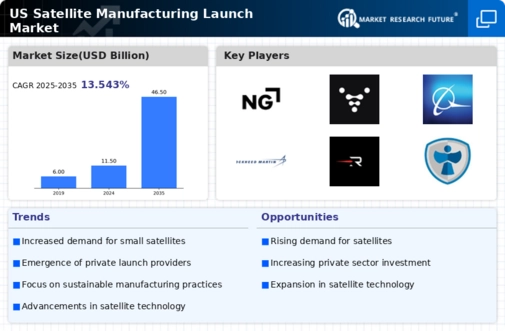Emergence of New Market Players
The satellite manufacturing-launch market is witnessing the emergence of new market players, particularly from the private sector. Startups and established companies are increasingly entering the market, driven by advancements in technology and reduced launch costs. This influx of new entrants is fostering competition and innovation, leading to the development of novel satellite solutions. For instance, companies are now offering rideshare launch services, which allow multiple satellites to share a single launch vehicle, thereby reducing costs for smaller operators. This trend is likely to reshape the landscape of the satellite manufacturing-launch market, as new players introduce diverse offerings and challenge traditional manufacturers.
Increased Investment in Space Exploration
The satellite manufacturing-launch market is benefiting from increased investment in space exploration initiatives. Government agencies, such as NASA, and private companies are allocating substantial budgets to explore outer space, which includes launching satellites for various scientific missions. In 2025, NASA's budget for space exploration is estimated to exceed $25 billion, with a significant portion dedicated to satellite missions. This influx of funding is fostering innovation and collaboration within the satellite manufacturing-launch market, as companies strive to develop cutting-edge technologies that can support ambitious exploration goals. As a result, the market is likely to witness robust growth driven by these exploration efforts.
Growing Demand for Communication Satellites
The satellite manufacturing-launch market is significantly influenced by the rising demand for communication satellites. With the proliferation of internet services and the need for enhanced connectivity, particularly in remote areas, the market for communication satellites is expanding rapidly. According to recent estimates, the demand for communication satellites is projected to grow at a CAGR of 8% through 2027. This growth is driven by the increasing reliance on satellite technology for broadband services, television broadcasting, and mobile communications. Consequently, manufacturers are focusing on developing advanced communication satellites that can cater to diverse consumer needs, thereby propelling the satellite manufacturing-launch market forward.
Regulatory Support for Satellite Operations
The satellite manufacturing-launch market is positively impacted by regulatory support aimed at facilitating satellite operations. The Federal Aviation Administration (FAA) and the Federal Communications Commission (FCC) are actively working to streamline the regulatory process for satellite launches and operations. Recent initiatives have focused on reducing bureaucratic hurdles and expediting licensing procedures, which is crucial for the timely deployment of satellites. This regulatory environment encourages investment and innovation within the satellite manufacturing-launch market, as companies can navigate the approval process more efficiently. As a result, the market is likely to experience accelerated growth, driven by a more favorable regulatory landscape.
Technological Advancements in Satellite Design
The satellite manufacturing-launch market is experiencing a surge in technological advancements that enhance satellite design and functionality. Innovations in materials science, miniaturization, and propulsion systems are enabling the production of more efficient and capable satellites. For instance, the integration of artificial intelligence and machine learning in satellite operations is streamlining data processing and improving decision-making capabilities. This trend is reflected in the increasing investment in research and development, which reached approximately $3 billion in 2024. As a result, manufacturers are better equipped to meet the growing demand for high-performance satellites, thereby driving growth in the satellite manufacturing-launch market.

















Leave a Comment